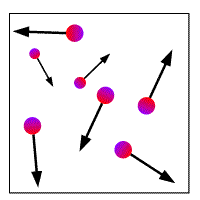|
The partial pressure of a gas is the pressure that it would exert if it were alone in the same volume. Partial pressure is given the symbol P(g) where g is the gas under discussion. |
Gas pressure
The pressure of a gas is caused by the collisions of the gas particles with the walls of the container. Such collisions are totally elastic and as each collision occurs a resultant force is produced. Gas pressure is the sum of all of these tiny forces per unit area. It is measured in Pa, which is a combined dimension from Nm-2, i.e. the force in Newtons per metre squared.
 |
A particle collides with the wall of the container causing a force acting perpendicular to the wall. The pressure is the sum of these forces per unit area. This pressure is measured in Newtons per metre squared = Pascals |
| Gas particles in a container | Nm-2 = Pa |
Question How can collisions be totally elastic?
This seems to be contrary to what we already know about colliding objects. It can be explained by considering that the walls of the container also have vibrating particles that can, in turn, transfer energy to the gas particles. Overall there is no energy exchange if the gas and the walls are at the same temperature (as they must be when the system is at equilibrium).
Mole fraction
The definition of mole fraction proves to be very useful in several areas of stoichiometry. It is defined as:
The number of moles of a substance divided by the total number of moles.
|
Example: A mixture contains three gases A, B and C, in proportions of 1 mole to 1 mole to 8 moles respectively. Calculate the mole fraction of gas A. The mole fraction of A is 1 mole divided by the total number of moles present = 1 + 1 + 8 = 10. Therefore the mole fraction of A = 1/10 = 0.1 |
Dalton's law
Two facts emerge from what is known about the causes of gas pressure:
In gas mixtures of two or more component gases:
1 Collisions by the molecules of each gas cause a pressure on the walls of the container, called the partial pressure.
2 The total pressure of a mixture is the sum of all of the individual partial pressures.
The ideal gas equation:
PV = nRT
when T and V are constant,
P ![]() n
n
i.e. the pressure of any gas is directly proportional to the number of moles of gas.
For a two component system, A & B
total moles = moles gas A + moles gas B
Hence, the total pressure is the sum of the partial pressures
P(total) = P(gas A) + P (gas B)
Finally, the partial pressure of an individual gas in a mixture is given by the mole fraction of the gas multiplied by the total pressure
P(gas A) ![]() moles(gas A)
moles(gas A)
From the above equations it can be derived that:
P(gas A) = P (total) x moles A/(total moles)
John Dalton put these ideas together into what is now known as Dalton's law:
- The partial pressure of a gas is equal to the mole fraction of that gas multiplied by the total pressure.
- The total pressure of a gas mixture is equal to the sum of the partial pressures of the individual gases.
|
Example: 2 moles of oxygen and 3 moles of hydrogen are contained in a vessel at 100 kPa pressure. Calculate the partial pressures of each gas. The total number of moles of gas = 2 + 3 = 5 The mole fraction of this total that is oxygen = 2/5 Therefore oxygen's contribution to the total pressure is 2/5 x total pressure = 2/5 x 100 = 40 kPa Similarly the partial pressure of hydrogen = 3/5 x 100 = 60 kPa |

